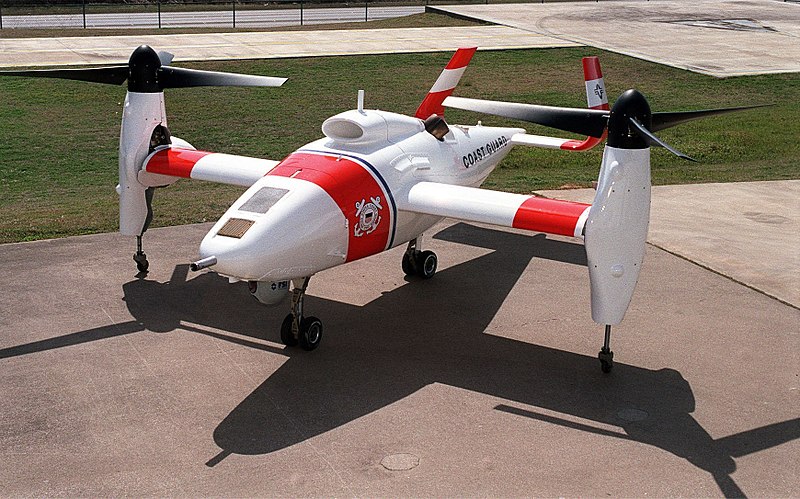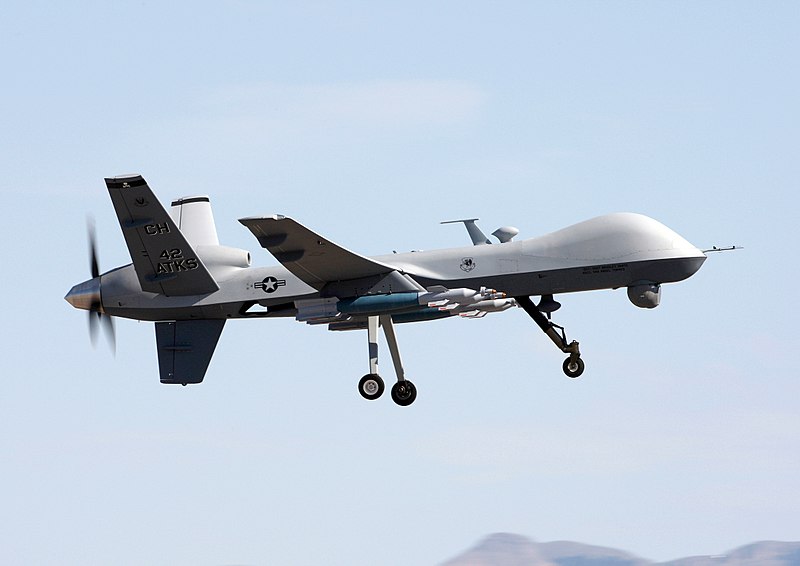Bell Eagle Eye
The Bell Eagle Eye, Model 918, is a United States tiltrotor unmanned aerial vehicle that was offered as one of the competitors in the U.S. Navy's VT-UAV (Vertical Takeoff - UAV) program.

AAI RQ-7 Shadow
The RQ-7 Shadow unmanned aerial vehicle (UAV) is used by the United States Army and Marine Corps. Launched from a trailer-mounted pneumatic catapult, it is recovered with the aid of arresting gear similar to jets on an aircraft carrier. Its gimbal-mounted, digitally-stabilized, liquid nitrogen-cooled electro-optical/infrared (EO/IR) camera relays video in real time via a C-band line-of-sight data link to the ground control station (GCS). The "R" is the Department of Defense designation for reconnaissance; "Q" means unmanned aircraft system. The "7" refers to it being the seventh of a series of purpose-built unmanned reconnaissance aircraft systems.
The Army's 1st Battalion, 210th Aviation Regiment at Fort Huachuca, AZ trains soldiers, marines, and civilians in the operation and maintenance of the Shadow UAV. The training program consists of mainly civilian instructors.

Northrop Grumman RQ-4 Global Hawk
The Northrop Grumman (formerly Ryan Aeronautical) RQ-4 Global Hawk (known as Tier II+ during development) is an Unmanned Aerial Vehicle (UAV) used by the United States Air Force and Navy as a surveillance aircraft.
In role and operational design, the Global Hawk is similar to the Lockheed U-2, the venerable 1950s spy plane. It is a theater commander's asset to provide a broad overview and systematic target surveillance. For this purpose, the Global Hawk is able to provide high resolution Synthetic Aperture Radar (SAR)—that can penetrate cloud-cover and sandstorms— and Electro-Optical/Infrared (EO/IR) imagery at long range with long loiter times over target areas. It can survey as much as 40,000 square miles (100,000 square kilometers) of terrain a day.
Missions for the Global Hawk cover the spectrum of intelligence collection capability to support forces in worldwide peace, crisis, and wartime operations. According to the Air Force, the capabilities of the aircraft allow more precise targeting of weapons and better protection of forces through superior surveillance capabilities.
The Global Hawk costs about $35 million USD[1] (actual per-aircraft costs; with development costs also included, the per-aircraft cost rises to $123.2 million USD each[2])

General Atomics MQ-9 Reaper
The General Atomics MQ-9 Reaper (originally the Predator B) is an Unmanned Aerial Vehicle (UAV) developed by General Atomics Aeronautical Systems (GA-ASI) for use by theUnited States Air Force, the United States Navy, the Royal Air Force, and the Italian Air Force. The MQ-9 and other UAVs are referred to as Remotely Piloted Vehicles/Aircraft (RPV/RPA) by the U.S. Air Force to indicate their human ground controllers.[3][4] The MQ-9 is the first hunter-killer UAV designed for long-endurance, high-altitude surveillance.[3]
The MQ-9 is a larger and more capable aircraft than the earlier MQ-1 Predator, although it can be controlled by the same ground systems used to control MQ-1s. The Reaper has a 950-shaft-horsepower (712 kW) turboprop engine, far more powerful than the Predator's 115 hp (86 kW) piston engine. The increase in power allows the Reaper to carry 15 times more ordnance and cruise at three times the speed of the MQ-1.[3] Although the MQ-9 can fly pre-programmed routes autonomously, the aircraft is always monitored or controlled by aircrew in the Ground Control Station (GCS) and weapons employment is always commanded by the pilot.[citation needed]
In 2008 the New York Air National Guard 174th Fighter Wing began the transition from F-16 piloted planes to MQ-9 Reaper UAVs, which are capable of remote controlled or autonomous flight operations, becoming the first fighter squadron conversion to an all-UAV attack squadron.[5][6][7]
Then U.S. Air Force (USAF) Chief of Staff General T. Michael Moseley said, "We've moved from using UAVs primarily in intelligence, surveillance, and reconnaissance roles before Operation Iraqi Freedom, to a true hunter-killer role with the Reaper."[3] As of 2009 the U.S. Air Force’s fleet stands at 195 Predators and 28 Reapers.[1]

Northrop Grumman MQ-8 Fire Scout
The Northrop Grumman MQ-8 Fire Scout is an unmanned autonomous helicopter developed for use by the United States armed forces.[1] Northrop Grumman is developing the Fire Scout to provide reconnaissance, situational awareness, and precision targeting support. The initial RQ-8A version was based on the Schweizer 330, while the enhanced MQ-8B is derived from the Schweizer 333.

Schiebel Camcopter S-100
The Schiebel Camcopter S-100 is a helicopter unmanned aerial vehicle (UAV).

Adapted From:http://en.wikipedia.org/wiki/





